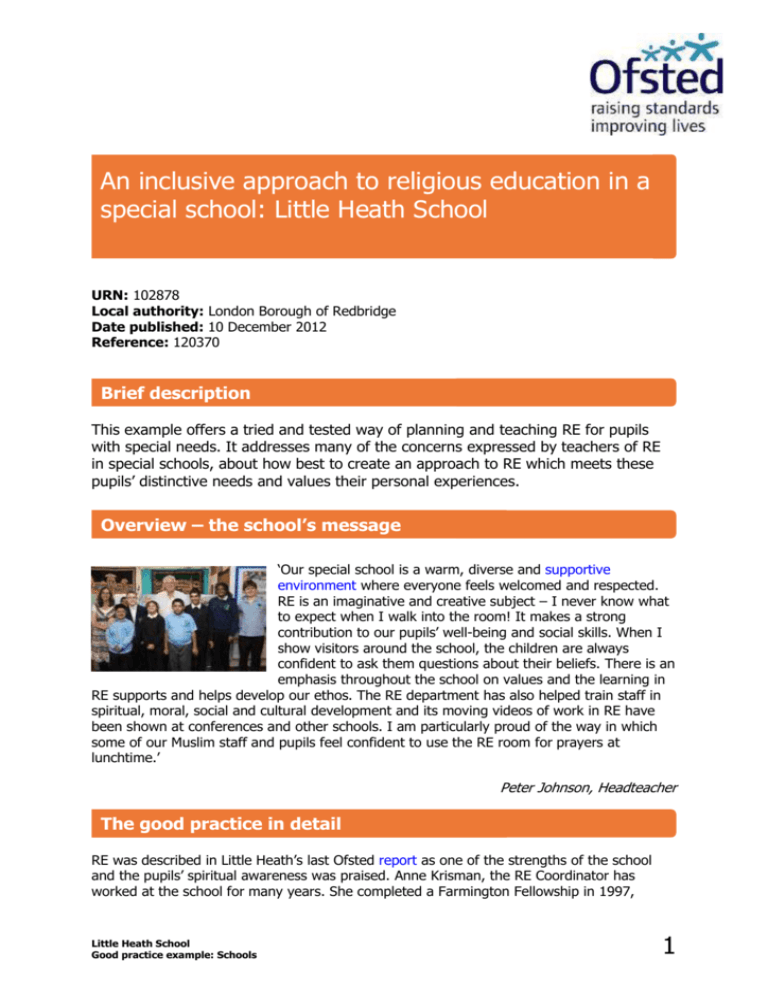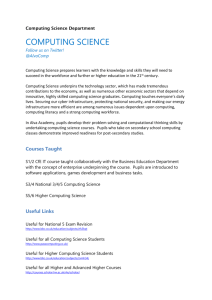V2 GPE template - Schools - 6Mar2012
advertisement

An inclusive approach to religious education in a special school: Little Heath School URN: 102878 Local authority: London Borough of Redbridge Date published: 10 December 2012 Reference: 120370 Brief description This example offers a tried and tested way of planning and teaching RE for pupils with special needs. It addresses many of the concerns expressed by teachers of RE in special schools, about how best to create an approach to RE which meets these pupils’ distinctive needs and values their personal experiences. Overview – the school’s message ‘Our special school is a warm, diverse and supportive environment where everyone feels welcomed and respected. RE is an imaginative and creative subject – I never know what to expect when I walk into the room! It makes a strong contribution to our pupils’ well-being and social skills. When I show visitors around the school, the children are always confident to ask them questions about their beliefs. There is an emphasis throughout the school on values and the learning in RE supports and helps develop our ethos. The RE department has also helped train staff in spiritual, moral, social and cultural development and its moving videos of work in RE have been shown at conferences and other schools. I am particularly proud of the way in which some of our Muslim staff and pupils feel confident to use the RE room for prayers at lunchtime.’ Peter Johnson, Headteacher The good practice in detail RE was described in Little Heath’s last Ofsted report as one of the strengths of the school and the pupils’ spiritual awareness was praised. Anne Krisman, the RE Coordinator has worked at the school for many years. She completed a Farmington Fellowship in 1997, Little Heath School Good practice example: Schools 1 exploring a new form of creative RE for children with special needs that valued their powerful life experiences rather than a traditional deficit model based on their limited literacy. She has found that teachers working with children with special needs in RE value clear guidance and a vision about what should be taught, and there are few examples of effective practice available to help them. Adapting schemes of work from mainstream schools can be challenging for teachers as there is complex content to cover. While the 1993 Education Act states that RE should be taught in special schools, ‘as far as is practicable,’ there are few guidelines on how to do this. Some Agreed Syllabuses suggest that special schools should teach the content of the agreed syllabus at a key stage below the actual age of the learners, without acknowledging the distinctive needs of children with learning disabilities. Effective planning The school has developed a new guiding structure for planning Religious Education for children with special needs called ‘Five Keys into RE’. This places the pupil at the centre of what is taught while taking into account the essence of the agreed syllabus. ‘Five Keys’ reflects the fact that the pupils need time to discover the deeper meaning of RE. Anne says, ‘As our pupils need time to process RE themes, we select only the pure essence of what should be taught.’ Themes and materials are selected to connect with the pupils, so that there is a clear relationship between RE and their lives. Sensory RE learning experiences are provided within a clear context. During ‘Celebrating RE’ month in 2011, Year 10 pupils were touched by a news story about the Japanese tsunami where children were waiting patiently at their school to be collected unaware that their parents were among the missing. The pupils explored some pictures of mothers and babies and reflected on the experience of Mary at the point of the crucifixion. They created mother and child images in their RE lessons. Their final sculptures became a tribute to the precious love that their parents and carers give. The Five Keys grid helps teachers to focus their planning: Key 1: Connection - what links can we make with our pupils’ lives? A bridge is created between the religious theme and the child meaning that learning is deeper. As Anne says, ‘The story of Diwali begins with the idea that sometimes we go away but it is good to be back home. We establish the link between pupils’ experiences of respite care, their daily journeys home, and the story of Rama returning from exile.’ Key 2: Knowledge – what is at the burning core of the faith? It is important to look into the heart of the religious theme to understand precisely what needs to be taught. ‘Key knowledge includes pupils’ understanding that Jesus loved everyone, especially if they were poor or unhappy; or that Sikhs have special teachers called gurus’, says Anne. ‘By cutting out peripheral information, and going straight to the core, we teach what is central and powerful.’ 2 Little Heath School Good practice example: Schools Key 3: Senses – what sensory elements are in the religion? It is important to include sensory experiences that are linked to RE. For example, a theme about Jewish prayer could involve wrapping a child in a large tallit, taking Makaton signs from the Shema, such as ‘heart’, ‘gate’, ‘children’, ‘love’; and signing these to Jewish liturgical music or touching a favourite picture between the eyes to show its importance. Key 4: Symbols – what are the symbols that are the most accessible? Symbols are an important way of conveying the spirituality of religion. They can be held like a brass Ek Onkar (the Sikh idea of the unity of God). They can be the focus of art work or experienced directly using a hoop to represent the kara (the Sikh bracelet), and travelling around it again and again by walking or in a wheelchair. This would show the eternity of God. Key 5: Values - what are the values in the religion that speak to us? While pupils with special needs may face many challenges, like other young people they have a strong sense of values. They are aware of others helping them in their lives and the importance of saying ‘thank you’. This Key makes values central. So, for example, a unit on the life of the Buddha might use a Jataka story to focus on the importance of patience. This links with pupils needing to wait for help with their work, or waiting for the school transport to arrive. How RE is organised RE is taught to each class between 11am and 1 pm once a week. A curriculum grid connects the subject to the expectations set out in Redbridge’s locally agreed syllabus. The distinctive approach is evident in this example of the detailed medium-term planning: Five keys into Diwali. Progress is seen through ‘inspirational moments’, rather than more formal assessments, for example, through observations of when a pupil suddenly drew a picture of Jesus on an empty cross template without being asked; when a child carefully handed an artefact to a classmate; or when a pupil who rarely made contact with others suddenly reached out to touch another’s hand during a peaceful group ceremony commemorating the tsunami. Rather than trying to carry out formalised continuous levelled assessment of progress in RE, the emphasis is on identifying where RE contributes to each pupil’s overall progress and targets. Extensive use is made of photographs and videos to record pupils’ achievements. Anne says, ‘I am most interested in recording significant insights the children have when they show flashes of understanding or where their learning has an impact on them. The importance of RE is that it also provides opportunities for children to reveal insights they could not have elsewhere.’ Little Heath School Good practice example: Schools 3 The subject is well supported by the senior leadership in the school. The freedom to explore this creative and innovative approach is encouraged, confident in the benefits it brings to the pupils. A recent focus day on spiritual, moral, social and cultural development provided a good opportunity to affirm and share the distinctive approach to RE and how it reflects and depends upon the wider values and ethos of the school. As well as conventional visits to places of worship, pupils have visited Muslim and Christian burial grounds to show support to classmates who had been bereaved during the year. What does the approach achieve? Putting RE and its messages at the heart of the school, reflecting shared values, has many benefits. Pupils find the way it is taught to be peaceful and supportive. At times, their own needs and behaviours can help them appreciate rituals of different faiths. They respond positively to stories that show change is possible, for example, the Buddhist story of Angulimala, the bandit. Many children have been drawn to devotional music from different cultures. A pupil with moderate learning difficulties gave a reflective leaving speech in which he bravely Creating Muslim calligraphy admitted he had once been ‘horrible and nasty’ but ‘now I realise that I had made the wrong path in life….now I am really trying hard to be very good for ever.’ This illustrates how pupils are able to use spiritual vocabulary with confidence, as these words and concepts are used in the classroom. One boy wrote a message to his friends who were leaving, saying, ‘My heart will always belong to you’. Examples of pupils’ work An example of work done by a Year 8 pupil, Sana, illustrates this approach well. After watching Si Smith’s film 40 about Jesus’ time in the desert, pupils talked about the difficult times they had faced in their lives and shared experiences of family breakdown, moving countries, illness and loss. Pupils wrote a class poem based on Ecclesiastes 3 1-8 ‘There is a time for everything in life A time to learn, a time to play with friends A time to be happy, a time to grow up A time to see my mum, a time to see my dad A time to cry, a time to laugh, A time to talk, a time for silence A time to celebrate, a time to pray A time to go to college, a time to have a baby A time to leave, a time to move on. 4 Little Heath School Good practice example: Schools Further information For further information about this work at Little Heath follow these links: Speak from the Heart: Exploring and Responding to RE in the special school Setting the Angel Free: Religion and Religious Education in a special school The school’s background Little Heath School is a special school catering for students with a wide range of needs, from moderate to severe learning difficulties. The complexity of students' needs has increased in recent years and there are a significant number with autism and speech and language difficulties. All have a statement of special educational needs and a small number have very specialist needs. Students come from a wide geographic area covering Redbridge and neighbouring local authorities. They are from a range of minority ethnic backgrounds with the greatest proportion from White British and Asian backgrounds. Very few are from homes where English is not the main language spoken. The school has a number of national awards including Healthy Schools, Sportsmark and the Spirited Arts award. Are you thinking of putting these ideas into practice; or already doing something similar that could help other providers; or just interested? We'd welcome your views and ideas. Get in touch here. To view other good practice examples, go to: www.ofsted.gov.uk/resources/goodpractice Little Heath School Good practice example: Schools 5





![afl_mat[1]](http://s2.studylib.net/store/data/005387843_1-8371eaaba182de7da429cb4369cd28fc-300x300.png)


